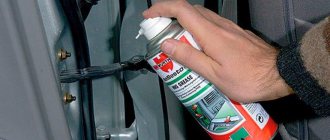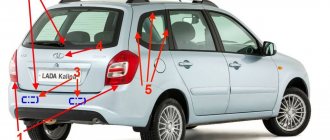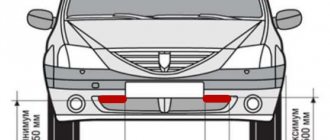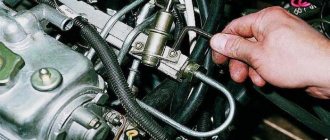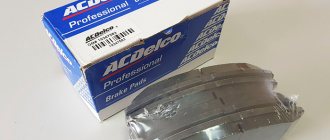1200 rub. for the photo report
We pay for photo reports on car repairs. Earnings from 10,000 rubles/month.
Write:
The rainy season always brings some new surprises to car owners. Either “triple”, or poor starting, and for some it’s even more original, such as water under the rug. What a surprise for the driver when, upon opening the car doors, he discovers a puddle of water either on the driver’s side or on the passenger’s side. The question immediately arises: where did the water come from?
It would be nice if there was some kind of rusty trough, then there would be at least some considerations, but it looks like it’s not old, but there’s a flood. Just to solve such issues, I will cite the main weak points and holes through which water leaks, by how to visually determine the influx of water it will not be possible at all... The problem seems to be general and applies not only to domestically produced cars, but also to foreign cars. The rug also often catches me.
Why is there water under the rugs in a VAZ 2114
If you don’t tackle the problem of how to dry the car interior under the mats in time, this seemingly trifle can lead to big troubles.
The unpleasant smell of stagnant, rotten water is the least of them. The constantly wet floor upholstery will begin to slowly rot, adding olfactory “joys”, and in the long term – reupholstery of the bottom. But this is not enough: constant humidity defeats even car painting, and measures not taken result in welding work - the bottom and sills simply rot. And liquid in the cabin appears not only as a result of various types of accidents such as antifreeze breakthrough, but also naturally - through leaky seals on windows or on riders' shoes in the form of snow. By the way, it is in the cold that puddles under rugs pose the greatest danger. In the summer, even a cabin flooded by a sudden downpour dries out naturally without outside help. In winter, the problem resolves spontaneously only for owners of heated garages or drivers with access to warm boxes. If you put off drying until warm days, in the spring you can poke a hole in the bottom with your finger. Or by this time you will get something lung-related from constantly inhaling mold spores.
How to dry the car interior under the mats? Several folk methods have been developed by those who have already encountered similar troubles.
What to do if water gets into the engine
If the car suddenly stalls after passing a water obstacle, you should not try to start it again. There is a risk that there is a water lock in one of the cylinders. In this case, you need to get to the repair site by tow truck or tow truck.
What to do next? You should open the hood and inspect which components have gotten wet.
It is important to dry the ignition system
Plugs and ignition coils
It is necessary to unscrew the spark plugs and coils and allow them to air dry. It is recommended to check and dry the air filter as well as the hose. Blow out the spark plug wells with compressed air, or crank the engine starter without installed spark plugs. So, some of the water will be pushed out.
initial stage
Before applying any selected drying, you should try to remove the maximum amount of water from the interior. For this:
- We remove the rugs (at the same time you can check whether they have become moldy and wash them);
- Raise the carpet and lay several layers of toilet paper underneath it. The option with newspapers is cheaper (they put a lot of spam out the window), but less effective - such paper absorbs worse. The feminine pads used by some originals are more effective, but they will hit your pocket hard. You can fill the space with hygienic litter for a cat litter box - it absorbs perfectly, but then you will be bothered to pick it out from under the upholstery. Those whose carpet is firmly fixed can take such a step only after serious dismantling, which not everyone will decide to do. If you skip it, further actions will take more time;
- The carpet is laid in place and covered with the same toilet paper, as thick a layer as possible;
- Next, the resulting “pie” must be carefully trampled, squeezing out the water. Several approaches may be needed. Our goal is to remove as much water as possible from the floor. The carpet and the top of the bottom will still remain wet, but drying them in the future will be easier, since a certain amount of water will not need to evaporate.
Starting after removing moisture
After the oil has been successfully changed, rushing to start the engine as quickly as possible is wrong. If the car is an old model and does not have an electronic control unit, then it is enough to unscrew the spark plugs, switch or coil and distributor. If you have an ECU, it is better to wait for the moisture to evaporate naturally. After removing the spark plugs, you can safely crank the engine using the starter, thereby drying the cylinders. For a full start, it is better to leave the car for a couple of days to completely evaporate any remaining moisture and ventilate it.
After a few days, you can put the spark plugs back in place and try to start the engine. If you can’t do this, you shouldn’t use any kind of sophistication for this. It is better to immediately call a tow truck or tug and go to the nearest car service center, where they will determine the cause as accurately as possible and eliminate the consequences using more technologically advanced methods.
Now, having found yourself in such an unpleasant situation, you also know what to do if there is moisture in the engine. There is no need to panic, turn off the engine immediately and do not wait for it to stall on its own due to water hammer.
Variety of methods
If we had a heated garage on hand, we could simply leave the doors open overnight (with the power turned off, of course). Since there is no such luxury, you will have to work with your hands.
The method is fast
. Take a hairdryer (preferably a construction one, not one borrowed from your wife) and dry the entire surface section by section. Vigilance is the highest - the temperature of the unit is about 400°C, so a fire can easily be started if you are not careful.
A method for the lazy
. The fan heater turns on, the doors close - and so on for about 3 hours. The disadvantages include: the need to connect it somewhere (so there must still be a garage, even if it is cold); uneven drying; Difficulty in directing it towards the floor. However, the latter can be overcome simply by running the fan longer.
A method for those who have air conditioning
. The car starts, the heater turns on, the air conditioner turns on to recirculate, the windows and doors close, and the owner walks around, breathes deeply and explores the familiar surroundings for a long time. The heater alone will not save you: humid air will circulate throughout the cabin, since the vapors simply have nowhere to go. The air conditioner will extract them and remove them overboard.
If you take care of dryness regularly, and not in emergency mode, then the standard stove found in every car will be enough. Just before leaving the car, you need to wrap or remove the floor mats, roll up the windows and turn on the heater for 10-15 minutes at maximum. Then one window is left slightly open (1-2 mm, so that it is not visible from the side and new water does not flow in), and the owner can go to sleep.
Puddle under the car - car fluid leaks: possible causes
This has happened to many. You enter the garage to get into your car and see a puddle of liquid underneath it. What could it be? Should I worry?
Just as the human body is full of fluids that allow it to function properly, a car has a variety of fluids that pump it around and allow it to function at its best.
Antifreeze vapors are harmful to health!
Smudges are visible on the upholstery, but traces of antifreeze are more clearly visible on the mat itself
Of course, soaking the interior carpet of a VAZ-2114 with antifreeze entails consequences. The most unpleasant consequence is the smell of coolant when driving.
Thus, antifreeze vapors not only cause an unpleasant odor, but due to their composition, they also settle in people’s lungs, which can cause harmful effects on the body.
So, if left in this environment for a long time, settled coolant vapors will cause asthma, chronic bronchitis, allergies, and in the worst case, lung cancer . Therefore, at the slightest appearance of antifreeze on the interior carpet, it is necessary to eliminate the cause.
The car smells like burnt rubber: 3 reasons
After heavy use, did the brakes and clutch burn out on a car with a manual transmission? As a result, the car smells like burnt rubber.
This also happens because the driver has been driving for a long time on the brakes or with the handbrake raised. If the brake pads are stuck, you may also experience a pungent, pungent smell of burnt rubber.
Reason #1: Burnt out brakes.
It's easy to find out why your car smells like burnt rubber. Have you noticed that after a long trip there is a foreign smell in the cabin? Park and check your brake discs. To do this, you need to carefully touch them with your palm and check the temperature.
Note!
If the problem is the brake rotors, they will be hot enough to burn you, so be careful. Did you find out that one drive is hotter than the others? This means that it is in this wheel that the brakes burn out.
If you sniff, you will smell the smell of burnt rubber coming from under this wheel. It is necessary to raise the car on a lift or with a jack. Then you should spin the wheel, while the brakes and handbrake should be lowered. Is the wheel difficult to turn? This indicates that there is some kind of malfunction in the pads.
We recommend
If you don't visit a car repair shop soon to fix the problem, your brake pads will wear out quickly. And this is provided that the brakes are slightly overheated.
However, the consequences can be much more serious. For example, the effectiveness of the brakes will decrease: the brake hoses will burn out. As a result, fluid will leak. The brake discs will move. If this happens, you will notice vibration when you brake.
Reason No. 2. Burnt out clutch.
If the clutch is burnt, the car will also smell like burnt rubber. In this case, the smell will be even more pungent.
When the clutch burns out, and not the brakes, the smell of burnt rubber is strongest in the car interior. The appearance of a burnt rubber smell indicates that the clutch is slipping, is badly worn, or needs adjustment.
If a system with hydraulic couplings experiences clutch slipping, the hydraulic system is faulty.
How do you know if the clutch is burnt out? To do this, you need to go to a service station, where specialists will check the clutch and identify any faults.
Reasons for the appearance of antifreeze under the rug
What are the reasons for such a dangerous effect:
- The stove tap broke.
- Rupture of the material structure or surface of the heater radiator.
How to fix
Now that the causes have been identified, it is worth considering possible solutions to the problem. Before we begin, it should be noted that these reasons can easily be eliminated independently and it is not necessary to contact a car service. Let's look at how to solve the problem of antifreeze on the interior carpet.
Stove faucet
In the process of replacing the stove valve
In this case, the leakage of antifreeze may be caused by the fact that the heater faucet has worn out. Mostly, the leak will form under the driver's mat and occurs only in a certain operating mode of the heater. This malfunction can be treated simply by replacing the heater tap.
Heater radiator
Faulty heater radiator
The second most common reason is a leak from the heater core. Here you need to be careful and quickly fix the problem, since antifreeze gets not only onto the interior mats, but also affects its location.
So, if coolant leaks out, there is a possibility of damaging other components, especially the main one - the electronic control unit.
Reasons for decreased performance
Despite the simplicity of the design, problems with the VAZ-2114 stove often arise. They are mainly associated with a drop in the performance of the heating system - the stove heats the air poorly, blows cold or slightly warm air. In this case, the reasons for poor operation of the stove can be both general (warming up is weak at any control unit settings) and when operating in a certain mode, for example, at idle. Or, for example, cold air or slightly warm air blows only on the side windows, and in other modes the heating works normally.
Common reasons why the stove stops heating:
- the heater radiator is clogged or an air lock has formed in it;
- when switched to heating mode, the heater damper does not fit tightly to the body, which is why part of the air flow moves bypassing the radiator and enters the cabin cold;
- the tap does not open completely - this is one of the main reasons for a poorly heating stove;
- the formation of cracks at the joints of the housing and air ducts, which causes strong dispersion of the air flow.
It is not difficult to determine the cause of a general decrease in the efficiency of the heating system. To find out why the VAZ-2114 stove does not heat well, you need to remove the side decorative panels from the center console, and then warm up the engine and turn on the stove at maximum power. After this, we try the antifreeze supply pipe to the heater radiator up to the tap and behind it. The same heating temperature of the tube on both sides indicates that the tap is working properly and the problem lies in the radiator. If after the tap the pipe is less warmed up, the tap is jammed or does not open completely.
After this, we determine the temperature at the inlet and outlet pipes of the radiator. If the heat exchanger is not clogged and there is no plug in it, then the temperature of the outlet pipe will be lower than the inlet pipe. But if the outlet tube is cold, antifreeze does not circulate through the radiator, which indicates the formation of an air lock (airing) or clogging.
A common cause of failure of the VAZ-2114 stove is wear and play in the sliders. Because of this, even when they are moved to their extreme positions, the cables do not bring the valve and dampers to the stop (the valve remains closed, and the dampers do not block the air flow channels). This problem can be easily resolved - you need to make an adjustment and shorten the cables a little.
The problem of insufficient heating of one of the zones is associated with a violation of the damper control. This happens due to the same wear on the sliders, the cable jumping off the damper levers, the damper axes jumping out of the seats in the body, which is accompanied by clicks.
In addition to weak warming up, VAZ-2114 car owners are faced with the fact that the intensity of air flow decreases. This happens due to the dispersion of air through the cracks at the junction of the body and air ducts, clogging the latter with debris - many owners do not install cabin filters, so leaves get into the air ducts and interfere with air movement.
conclusions
The reasons and methods for eliminating the effect of antifreeze leaks on the interior mats in the VAZ-2114 are considered. So, when a motorist discovers such a problem, he must eliminate it immediately, because the consequences can be very diverse. If the car owner is unable to solve the problem, it is recommended to contact a car service center.
I came across this problem, yesterday I drove all day in the rain and in the cabin where the front passenger seat is at the feet, water formed under the rug from nowhere. what could it be??
- Need advice on headlight repair! BMW M6 E64 Cabrio
- help out
- repair assistance
- Reverse light does not work
- Long-term storage (1.5-2 years)
- The hazard lights come on when the engine is off and the doors are closed. BMW 3 E46
Alternatively, the windshield seal may be leaking. I had the same problem and was cured by replacing the seal.
Windshield seal, gasket seal under the fuse block, on the heater motor side, but unlikely.
The seal is unlikely, I checked it. the fact is that it was wet where the feet were, everything was dry near the stove and even from the door.
Well then, look from below, the rubber plugs in the bottom are in place.
Take a good look at the fuse block, maybe there is a crack somewhere and it is leaking. Get into the pedal and look at the cable going to the motor, it’s sealed in the body so water can get in there. Well, as an option, where the casing for the stove is located under the hood, there should be a sealant or some type of plasticine, because it can fly in from there.
I had the same thing, the channels under the hood were clogged with water draining, water got into the cabin through the stove - one of the options is the fuse box, from the seal, from the bottom from the plugs, the window was open, there are no other options. Well, maybe the stove is leaking or the stove faucet is leaking, then the stove will be dry.
Where does water come from?
Water can be poured through the stove air intake (depending on the model, it appears both on the left and on the right side of the tunnel at the feet). In such a situation, you need to clean the drain holes in the engine compartment, and then coat the joint of the body and the air duct with sealant . If the liquid is from the side of the stove, then first of all it is worth checking whether it is antifreeze (the faucet often leaks simply through clamps and pipes or the heater radiator). The heater can also leak through the engine.
This is where water can flow into the Hyundai Accent
It is possible that water may leak through the gasket in the mounting block and fuse box. Also, in domestic cars, liquid leakage through the windshield frame can occur ( water leaks in the corners ). This situation can arise for several reasons:
- First, the drain holes may be clogged (they need cleaning).
- Secondly, the seal may not adhere tightly to the glass (due to drying out or cracking).
- Thirdly, perhaps the formation of a gap between the glass and the body.
It is not uncommon for water to seep through rubber door seals (torn, shriveled rubber) that need to be replaced. How simple would it be? But a lot also depends on the installation of the seal; it happens that it was simply installed incorrectly, here you need to be extremely careful. Or because the doors have sagged or are not adjusted correctly. This results in water pouring in through the doorways. In rare cases, water gets into the steering rack or cables from the driver's side.
Water under the passenger mat of a VAZ 2114 can appear for various reasons. Every owner takes care of his own car, and as soon as even a small malfunction occurs, he immediately begins to sound the alarm, trying to quickly “cure” the car. It would seem that water under the passenger mat of a VAZ 2114 does not cause much concern, but this must be eliminated immediately so that there are no more serious problems in the future.
Methods for drying car interior floors under mats
Moisture in the car interior is an extremely undesirable phenomenon. Despite the apparent triviality, over time it can lead to irreparable consequences, so every responsible car owner strives to immediately eliminate the source of possible troubles. If drying the interior of a car in summer is not difficult, since all external conditions are favorable for this, then in winter drying becomes a real problem. Driving in a wet car is a dubious pleasure. In addition to the fetid smell of stagnant water and mold, which does not add comfort at all, an even greater evil is the swollen and rotting car floor upholstery. If the problem is not corrected in time, dampness threatens to destroy the bottom, and can also lead to short circuits in the on-board network, so you should start drying the interior if moisture gets in immediately.
Ways to get rid of moisture under car mats.
Reasons why water gets into oil
As mentioned above, one of the signs is a decrease in coolant. If this is the case, then there are several options:
- Leaking cylinder head. It happens that the gasket “breaks”, accompanied by a characteristic whistle, so it can be diagnosed quite easily.
- Leakage of pipes. This is also a common problem, but there are quite a few places where the coolant comes into contact with the oil. It's also easy to determine.
- Crack in the engine jacket. There is nothing you can do to help here, such details only need to be changed.
But it also happens that water in oil is not a consequence of a malfunction, but the natural course of things. This often manifests itself during short trips, especially in winter, and in summer not everything is so smooth. So, let's look at each season separately.
Operation in winter
The problem with winter is the low outside temperature. We started the engine, warmed it up, drove where we needed to go, returned and parked the car. This is perhaps the most common scenario for using a car.
So, above the oil level in the engine there is free space that is filled with air
It doesn't matter where he comes from, he just exists. But at the same time, its humidity is usually higher than in the external environment, because the oil covers all internal parts
And it uses so-called esters, they are designed to play the role of a kind of silicone in order to maintain lubricating properties. So these same esters are very hygroscopic. This means that they absorb moisture. Thus, over time, the air humidity in the engine crankcase reaches 90 percent.
The fact is that circulating the same amount of water in the crankcase is not as critical as constant replenishment. Crankcase gases that break through the piston rings also have a certain amount of moisture, which means the overall concentration increases.
Operation in summer
In summer, as it may seem, there is no such disease, because there are no temperature changes. In fact, this is partly true. But there is another problem. And it lies in the fact that air humidity in the summer is much higher, which means water accumulates in the crankcase faster. Now let's look in general. Initially, the normal amount of water in oil is up to 5 grams per 1 liter (0.5%).
This is exactly how it is sold in the store. If the norm is exceeded, the batch is sent to scrap. About 500 grams of water will settle from one cubic meter of air at a temperature of 90 degrees (operating temperature).
The average volume of air in the crankcase is approximately 20 liters. This means that at 60% humidity the engine will gain about 6 grams per cooldown. Let's take the average volume of oil in the engine to be 6 liters. In total, we obtain a concentration of water in oil of 0.01%. These are average numbers. There are 365 days in a year, respectively, the engine will receive a moisture dose of 0.365%. We do not include days with high humidity here. Thus, water in oil can appear simply from time to time.
Why does the interior floor become wet?
The most exposed place in the cabin to moisture is the car mat; it is the one that takes the blow most often during the rainy season or in winter. If the driver left the car with the windows slightly open and during his absence there was heavy rainfall, a few minutes is enough for water to get inside, soaking the upholstery and floor. If you give a ride to a wet passenger, the effect is the same; snow or mud can easily get on your shoes. However, it is not always so obvious where the water comes from under the carpet in the car. Humidity can also be caused by the following reasons:
- Violation of the integrity of the rug;
- Depressurization of the interior, for example, due to wear of seals or poor-quality assembly after body repair;
- Formation of condensation caused by temperature differences and poor air circulation in the cabin;
- Malfunctions of the air conditioner or heating system;
- Unsuitable car mats that do not fit tightly to the floor;
- Using textile mats not intended for use in such conditions in winter or rainy weather;
- Poorly performed interior dry cleaning and car washing;
- Moisture under the mat could be due to spilled liquid, leakage of antifreeze, etc.;
- The presence of water under the passenger seat is inevitable if you get into the car with wet clothes;
- Submerging a car in water.
No matter where the water in the car comes from, and no matter the scale of the situation, it is better to start drying immediately, without waiting for the dampness to completely take over the area. In some cases, the problem can be solved in a few minutes using improvised means, while in others you will have to tinker a lot, using “heavy artillery” for drying or even resort to the help of specialists.
Lada 2112 Angel of QuartZ › Logbook › Water in the cabin (Possible causes)
This article was written with my own hand, so that you don’t suffer like I did :))
To start looking for a water problem, do you need to analyze the problem?
1. Water enters ONLY when moving
car in rain/wet weather2.
Water gets in CONSTANTLY
If this is option 1, then you need to check
all rubber door seals, especially the lower part.
Inspect the door upholstery after “bad weather.” If the upholstery is damp, most likely there is no plastic film in the door that seals it from the upholstery. If it is in place, then we go to the store and buy a door seal and an upper drain, adjust the locks, ensuring that the door is pressed tightly against the rubber seal. Tip:
For tighter contact between the seals and the door, you can insert a silicone hose inside the seal along the entire length of the seal. You can read how to do this here (Refinement of seals 2110)
If in your case water gets into the cabin even when parked in rainy weather, then read below:
Water under sound insulation in the cabin under standard sound insulation may appear for the following reasons.
1. Poorly glued/unstuck windshield
One of the most common causes of water leaking into the cabin. This defect is quite difficult to see; it mainly flows in the lower corners. In the upper ones everything is much simpler, water flows along the windshield pillars or through the sun visors
2. Absence of plugs for the hydraulic corrector/clutch/wire harness going from the ECU to the engine compartment.
This defect can be determined by visual inspection.
Hydrocorrector plug
- may be missing or hanging on the hydraulic corrector pipes, for the reason that there are crooked craftsmen who conduct wiring for the alarm system through this hole, thereby removing the plug and forgetting to put it in. You can find it from the inside if you open the mounting block and feel hydraulic corrector pipes and follow their direction, behind the standard Shumka you can feel the hole. From the outside the process is more complicated, but much more reliable.
We remove the frill, move aside the coolant expansion tank, crawl up to the trapezoid drive mounting bracket (I don’t know what its scientific name is) and you will see a technological hole under it. You can put a plug and fill it with sealant for reliability. The clutch plug
is a sick part of the 10th family, frequent cable breaks.
If you replace it yourself, you may not install the plug tightly or even not install it at all. The wiring harness
going to the ECU from the engine compartment can be found just below the steering rack. A common problem is that this harness is wrapped in corrugation, which in turn is cut in half, the cut is directed towards the top :)) It may also have a plug missing or not fit tightly into the body.
3. Drain plugs in the bottom
This is actually a controversial point. There are myths that if you do not install plugs, the condensate can drain on its own. But logically, standard sound insulation can absorb water.
4. Holes in the bottom
. I think no comment
5. Maybe coolant?
Make sure that in your situation it is water that is flowing onto the floor, and not coolant. The coolant has a characteristic odor in the cabin and the liquid itself. Possible reasons: The heater pipe, faucet, radiator are leaking.
6. The clutch pedal housing is not sealed
What to do if there is little moisture
Of course, it is better to prevent the appearance of moisture in the car interior than to deal with it later. Motorists who pay attention to car care in order to avoid unpleasant consequences are no less concerned about maintaining dryness than replacing consumables.
It is also important to regularly monitor the integrity of the insulating materials, because the seals wear out over time and can let water in from the outside. In case of wear, it is better to replace the insulation immediately.
In summer, you can easily provide conditions for quickly removing moisture; to do this, simply open the windows or doors so that warm air flows circulate well. If the car is equipped with a climate control system, then in any bad weather you can organize a suitable microclimate in the cabin. The “Window Defrosting” option will help get rid of excess humidity. Of course, you should not only brush snow off your clothes and shoes when getting into the car, but also use the right mats so that moisture doesn’t have a chance in the first place. In winter, you should not use textile car mats; rubber ones are better for this period, since they are easy to remove water from. By leaving your car in a heated garage with good ventilation, you don’t have to worry about the accumulation of moisture in the cabin. Drying will not be difficult even in winter if the room is well ventilated, since the water evaporating from the heat will not settle as condensation. So, if you leave the windows or car doors open in such a garage, the problem will be solved spontaneously.
How to prevent fogging in summer when it rains
Most often, the windshield fogs up from the inside in rainy weather. Therefore, it is advisable to take care of this problem in advance. Here's what you need to do to achieve this.
- You should monitor the condition of the interior. It must be dry.
- Before boarding passengers, you need to warm up the car.
- You can use specialized tools. The main thing is that the anti-fog is of high quality, otherwise stains on the glass are inevitable.
- It is necessary to clean your car windows periodically.
- If you have air conditioning, before the trip it is advisable to turn it on and direct the air flow to the glass.
Actions to take when the floor is very wet
In case of more global flooding of the interior, for example, when the car has scooped up water from a deep puddle or dived into a body of water, the problem cannot be solved by the methods discussed. If you can drain the main water yourself, then for complete drying it is better to use the services of professionals, since in this case you cannot hesitate. The longer the interior is in contact with water, the higher the likelihood of moisture penetrating into the noise and heat insulation layers of the upholstery. In addition to worries about removing water from the floor, in this case you will have to disassemble the upholstery for subsequent drying. This will require a lot of time and space where the materials will need to be dried, but if everything is done correctly and quickly, then the appearance of mold, the unpleasant smell of dampness and other related problems can be avoided.
The water in the car under the carpet can be easily pumped out with a vacuum cleaner at the car wash, after which you can directly dry the interior. It’s up to you to dry the interior yourself or resort to the help of specialists, but you cannot expect that the moisture will go away on its own, nor can you delay the event. Where dry cleaning services are available, there is also special equipment that allows you to thoroughly dry your car. This option will lead to the desired result faster and will also save you from unnecessary hassle, while the main thing in achieving the effect is high-quality performance of the work.
Source
How to get rid of dampness in a car
Every motorist knows the problem of moisture in the cabin. It is because of it that the windows in the car fog up, the floor rots, the feet get wet, and the shoes deteriorate. Of course, you can carefully drain the water from the rugs and prevent it from accumulating there at all. But... well, about this; but don’t forget that it’s not always possible!
There are several more ways to help you get rid of moisture in your car! And today, we will look at them!
Products for inventors
Source: https://izobreteniya.net/kak-izbavitsya-ot-syrosti-v-mashine/
Cleaning the windshield washer nozzles
Windshield washer nozzles also do not often attract the attention of car owners. As a result, many car enthusiasts often ignore these sprayers, which play an important role in car safety. You must remember that windshield washer nozzles are necessary to properly clean your windshield while your vehicle is moving. Yes, windshield wiper blades are also very important. But how the windshield washer nozzles work will determine how the blades clean the glass.
Did you know that those washer fluid nozzles can get clogged? In this case, the quality of windshield cleaning drops significantly. For example, if the nozzle is partially clogged, the windshield will not be washed sufficiently with the windshield washer.
As a result, the wiper blades will not be wet enough, which will lead to poor cleaning of the glass surface. This not only shortens the life of your blades and windshield, but also directly affects your safety while driving. After all, the worse the visibility of the road, the greater the risk of getting into an accident. Also, a dirty windshield puts a lot of strain on the driver’s eyes, which can affect his health.
